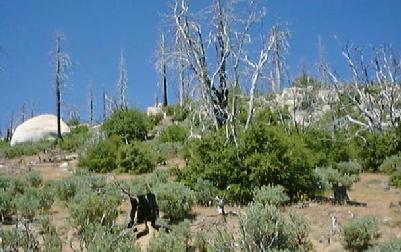
Yosemite National Park
Day One - water, or lack thereof

Don Pedro Lake, on the road to Yosemite National Park
Thursday 22nd July - Friday 23rd July 1999
As we caught the BART (Bay Area Rapid Transit) from San Francisco to Pleasanton, Veronika and I were discussing our travels, and we decided that we had largely seen enough of American cities for just now, and that it would be good if we could see some of the natural wonders for which America is so famous. And then, when we arrived in Pleasanton and were having dinner on our first night, my cousin Tom said that he had been thinking about going with his boys, Carter and Cody, to Yosemite on an overnight camping trip. Veronika and I were of course extremely enthusiastic, and so it was agreed. Our ever-handy guidebook gave us the phone number for Yosemite reservations, and we were able to book a couple of tent sites for Thursday night without any problems. The trip was on!

The weird landscape in the aftermath of a major forest fire
We hit the road fairly early, since the journey from Pleasanton to Yosemite is a good three hour drive. En route we stopped of at a view point to check out the beautiful Don Pedro lake (see above), a popular area for watersports enthusiasts in the Bay Area. As we wandered along a path a short way to stretch our legs, we came across a makeshift memorial at the site where an Argentinian tourist had been found murdered after disappearing with two American friends in the Yosemite valley. This was not perhaps the best of omens, but we did not let it dampen our spirits as we looked forward to the beauty of Yosemite.
The first thing we did on arrival at the park was to check in for our camp site, which was surprisingly spacious. We'd brought two tents with us, although the area we were allocated could probably have taken four tents or more. As we entered the camp site we were given leaflets explaining how to prevent what are termed "human-bear incidents". There were apparently over 1300 such incidents last year alone, although with 4.1 million visitors a year, that works out at around 1 for every 3000 visitors. Bears apparently treat any scented item as food, including toothpaste, and have been known to break into cars for an empty can of juice, so extreme caution must be taken to ensure that no traces of food are left. To facilitate this, the park service provide handy bear-proof metal boxes for food storage at each camp site, and we made very sure that we used them fully.

El Capitan
As you make your way into Yosemite Valley, your eyes are suddenly drawn to a huge monolith, El Capitan,

Veronika in her environment
Another of the major features of Yosemite is the spectacular waterfalls which proliferate around the valley. Although not as broad as Niagara Falls, the upper and lower Yosemite Falls descend 2425 feet, together the tallest waterfall in North America. At the foot of most of the waterfalls are large piles of boulders, the remnants of cliffs collapsing into the aters below. These boulders were almost made for clambering, and my young cousin Carter showed himself to be a natural. He has all the makings of a great climber in a few years time. To get the best views of the falls, you have to scramble over the rocks, and there's usually a small pool at the bottom of the falls.

Yosemite Falls, the tallest in North America;
the people at the very bottom give some idea of scale
Next | Travel index | Family history | Romany | Main index